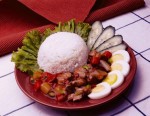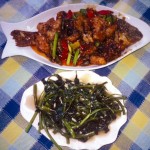Home Gourmet for Everyone
 The three daily meals enjoyed by Chinese families are what we call “common home gourmet.” Most ingredients found in home-cooked meals are taken from ordinary grocery and spice list. And the only principle that it abides by is good flavor. The so-called “common home style” also means that it is flexible and ever-changing, full of varieties and does not stick to just one form of cooking. The Chinese, who pay great attention to food, will not settle for bland and identical taste everyday. Under the tenet of a simple and non-luxurious life, cooking homemade dishes is certainly no easy task, as the food not only must entertain the taste buds of the family members, but must also be constantly changing in variety and combination. In general, home meals do not differentiate between “regional styles.” However, due to the fact that China has a vast expanse of territories, with products and living habits different in each area, it objectively creates for the situation where home-style cooking tastes different in each and every home.
The three daily meals enjoyed by Chinese families are what we call “common home gourmet.” Most ingredients found in home-cooked meals are taken from ordinary grocery and spice list. And the only principle that it abides by is good flavor. The so-called “common home style” also means that it is flexible and ever-changing, full of varieties and does not stick to just one form of cooking. The Chinese, who pay great attention to food, will not settle for bland and identical taste everyday. Under the tenet of a simple and non-luxurious life, cooking homemade dishes is certainly no easy task, as the food not only must entertain the taste buds of the family members, but must also be constantly changing in variety and combination. In general, home meals do not differentiate between “regional styles.” However, due to the fact that China has a vast expanse of territories, with products and living habits different in each area, it objectively creates for the situation where home-style cooking tastes different in each and every home.
It is common belief that dinner is the one meal that the Chinese take most seriously, whereas breakfast is the simplest. At a breakfast table of the Chinese, the most common food is the stuffed or plain steamed buns with a bowl of porridge (congee) and a dish of pickled veggies; we could also see wonton, hot soup noodle, rice and stir-fried dishes. Though the “deep-fried twisted dough stick” and soybean milk are standard breakfast items, few families make them at homes, as they are usually purchased from breakfast shops. Milk, oatmeal, or egg and ham sandwiches are no longer rare and fancy in the eyes of the urban population. Eggs and bean curd are the general source of protein in breakfast and are easy to prepare. For lunch and dinner, aside from rice and pasta, there are also stir-fries, soups and porridge for complement. The preparation of homemade foods is usually the responsibility of the female heads of households. But in families with double income, where both the man and woman earn a living, it is not uncommon for a man to make the meal.
Different from the West, the majority Han Chinese and most Chinese minority nationalities have little dairy beverage each day. But for the northwestern minority nationalities, dairy products are an important component of daily diet.
In areas where pasta and pastry are the principal food components,  homemakers can usually use wheat flour, corn flour, sorghum flour, soy flour, buckwheat flour or naked oatmeal flour to make a wide variety delicious treats. According to different taste preferences, pasta dishes can be stir-fried, fried, stewed, steamed, braised, simmered and so on. When having a bowl of pasta, jiaotou, or pasta sauce, is a top priority, and usually comes in the form of fried bean sauce (usu. with minced meat), soy gravy, dipping, soup stock and so on. Second priority to eating pasta is the shredded vegetables mixings, the types of vegetables vary during the seasons. At the birthplace of Chinese pasta, Shanxi Province, there are at least 280 types of pasta in the cookbooks.
homemakers can usually use wheat flour, corn flour, sorghum flour, soy flour, buckwheat flour or naked oatmeal flour to make a wide variety delicious treats. According to different taste preferences, pasta dishes can be stir-fried, fried, stewed, steamed, braised, simmered and so on. When having a bowl of pasta, jiaotou, or pasta sauce, is a top priority, and usually comes in the form of fried bean sauce (usu. with minced meat), soy gravy, dipping, soup stock and so on. Second priority to eating pasta is the shredded vegetables mixings, the types of vegetables vary during the seasons. At the birthplace of Chinese pasta, Shanxi Province, there are at least 280 types of pasta in the cookbooks.
For homes with rice as principal food, nothing is more common than a pot full of steamy, savory rice. But day after day, this becomes rather monotonous. So people spent much time in coming up with different ways of cooking and combinations. Steam, boil, stir-fry, roast, deep-fry and simmer, different ways of cooking bring out drastically different texture and taste in rice. In daily life, the Chinese usually would not and need not have excessive meat dishes. More often, inexpensive vegetables with good value are preferred. Turnips or radishes, green vegetables and bean curd are almost indispensable from each Chinese household. Green turnip, white turnip, radish and carrot are available throughout the country all year round. These veggies can be eaten raw, boiled, stir-fried, pickled and so on. “Green vegetables” include Chinese cabbage, spinach, rape, celery, Chinese chive (leek), mustard and more, where we eat their leaves and stems. Common ways of cooking green vegetables is none other than cold dish with dressing, cooked or stir-fried, and boiled or stewed. If one dislikes certain vegetables for they do not facilitate the eating of rice very well, small amounts of meat or eggs can be mixed in for stir-frying. For bean curd, the most common and simplest way to prepare is to serve cold with sauce or boil with water then dress in soy sauce, sesame oil sauce or other sauces. Tofu that is deep-fried and then baked with sauce or stewed with vegetables is also very common. In all the Chinese restaurants around the world, Mapo Tofu, meaning numb-hot bean curd, can be found. It is prepared simply by placing diced bean curd into pre-cooked minced meat, and after fully boiled, add some hot sauce and Chinese prickly ash powder, and there you have a fully prepared dish. Aside from tofu, other kinds of food made from beans, which belong to the same family as bean curd, are also common dishes during all seasons of the year.
The Chinese usually classify meat dishes into four categories, which are “chicken, duck, fish and meat.” But with developments in modern breeding industries, pork has replaced chicken, and became the most common meat for most Chinese nationalities, with Han Chinese especially. In the past, it was because pork is hard to come by, now because it can be enjoyed very often; ways of cooking for pork are the most numerous among all the meats. These include stir-fried, simmered, white-cut with sauce, twice-cooked, steamed with sauce and turned upside-down, steamed with ground rice, boiled in hot oil and so on. Most families can make these dishes. For home cooked pork, many people like to use starch, so pork stir-fry feels even more tender.
The Chinese have quite a long history of breeding chicken. Since ancient times, the Chinese have considered Chicken to be of great taste and regard chicken soup as a great tonic drink. Chicken can be steamed or stewed in clear soup, simmered with soy sauce, white-cut with dipping, or stewed in yellow wine, with no less than a dozen ways of preparation. Just the recipes for chicken can be compiled into thick books. Compared with chicken, ducks have a much higher price tag in northern China. Common northern families ” href=”http://www.chinascan.org/archives/711/fish”>![]() seldom cook duck though, as the famed Beijing (Peking) Roast Duck has to be enjoyed in special restaurants. The place most skilled in making duck dishes is the Jiangsu-Zhejiang area. There, Salty Watered Duck and Laobao Duck are not just treats of recognition of restaurants; many homemakers can make the dishes well too. There are many ways to cook fish as well. Most times, fresh fish is steamed or simmered in clear soup. Fish a little lesser in freshness would be braised, or one can add sugar and vinegar for Sweet and Sour fish. Beef and mutton are the principal foods of western Chinese minority nationalities. Most common are barbecue beef or lamb. But in most Han Chinese homes, aside from quick-fried, stewed in soy sauce, or simmered, the most popular way of preparing beef and lamb is none other than “rinsing” in a boiling hotpot.
seldom cook duck though, as the famed Beijing (Peking) Roast Duck has to be enjoyed in special restaurants. The place most skilled in making duck dishes is the Jiangsu-Zhejiang area. There, Salty Watered Duck and Laobao Duck are not just treats of recognition of restaurants; many homemakers can make the dishes well too. There are many ways to cook fish as well. Most times, fresh fish is steamed or simmered in clear soup. Fish a little lesser in freshness would be braised, or one can add sugar and vinegar for Sweet and Sour fish. Beef and mutton are the principal foods of western Chinese minority nationalities. Most common are barbecue beef or lamb. But in most Han Chinese homes, aside from quick-fried, stewed in soy sauce, or simmered, the most popular way of preparing beef and lamb is none other than “rinsing” in a boiling hotpot.
All regions have dried or pickled vegetables, beans, eggs or meats. These foods intended for prolonged storage, are becoming less of a real course during meals as living conditions improve, but more of a tasty appetizing treat.